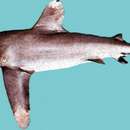Red List Category & Criteria: Endangered A2b (Regional assessment)
ver 3.1 Year Published: 2015
Date Assessed: 2014-11-18
Assessor(s): Walls, R., Soldo, A. & Buscher, E.
Reviewer(s): Dulvy, N.
Contributor(s): Fordham, S., Baum, J.K., Medina, E., Musick, J. & Smale, M.
Facilitator/Compiler(s): Walls, R. & Dulvy, N.
Justification: European regional assessment: Endangered (EN) This formerly widespread and abundant, large oceanic shark is subject to fishing pressure throughout its range. It is caught in large numbers as a bycatch in pelagic fisheries, with pelagic longlines, probably pelagic gillnets, handlines and occasionally pelagic and even bottom trawls. Catches, particularly in international waters, are inadequately monitored. Its large fins are highly prized in international trade although the carcass is often discarded. Declines of 90% according to observer data from the Pacific are probably the most reliable available data on this species today, and with the same types of fishery in operation throughout its habitat worldwide, it is realistic to assume that it might be faring similarly in the Atlantic Ocean.
Estimates from the Northwest Atlantic are available and indicate a decline of 80-85% from 1950s-2000, but these are contended and may not reflect the status of the European subpopulations. Therefore, it is estimated that the species has declined by at least 50% for the three generation period (46 years) in European waters, therefore qualifying as Endangered under criterion A2b. It should be noted that this region only represents a portion of the Atlantic-wide subpopulation, which likely spans the entire Atlantic Ocean. For this reason, this information should be updated following further analyses of relevant Atlantic fisheries data.

